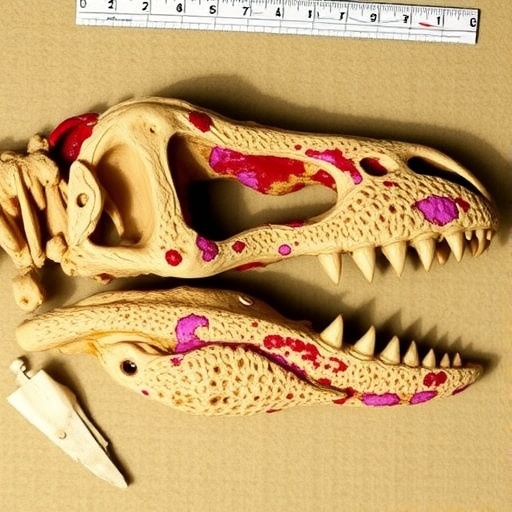In a groundbreaking study, a team of paleontologists led by M.S. Garcia has uncovered compelling evidence suggesting that some of the earliest predatory dinosaurs engaged in intraspecific agonistic behavior, a phenomenon indicative of aggression within the same species. This revelation was made as researchers examined craniofacial lesions found in fossilized skulls dating back to the dawn of the dinosaur era, approximately 230 million years ago. These findings provide critical insights into the social dynamics of early dinosaurs, challenging traditional views of their behavior and ecology.
The study, published in the prestigious journal Sci Nat, details how the analysis of cranial injuries shed light on the aggressive interactions that likely took place between members of early predatory dinosaur species. The lesions were not the result of environmental hazards or accidents, but rather the result of confrontations among individuals. The implications of such findings are profound, as they suggest that these dinosaurs could possess complex social behaviors similar to those observed in modern-day carnivorous mammals.
Key characteristics of the lesions analyzed include puncture wounds, gashes, and fractures, all of which appear to align with combat-related injuries seen in contemporary animal species. This remarkable correlation allows paleontologists to draw parallels between the behavior of early predatory dinosaurs and that of current carnivores such as wolves and lions, who often exhibit territorial disputes and aggressive confrontations within their own species. The evidence suggests that similar social structures and hierarchies may have existed among these prehistoric reptiles.
Furthermore, the craniofacial injuries have been closely examined for their locations and severity. This careful analysis has enabled researchers to hypothesize that males may have engaged in more frequent and violent conflicts, likely driven by competition for mates or territory. The idea of sexual selection contributing to aggressive behavior is not new in the field of zoology, but applying it to ancient reptilian species opens an entirely new avenue for understanding the evolutionary pressures that shaped their development.
The findings also pose interesting questions about the social structures of these dinosaurs. It raises the possibility that early predatory dinosaurs may have lived in groups or packs, where social interactions dictated not only their hunting strategies but also their reproductive success. This line of inquiry is essential as it provides a more nuanced understanding of the ecology and evolution of dinosaurs, suggesting that their behaviors were influenced not just by their environment but also by their social dynamics.
Additionally, researchers employed state-of-the-art imaging techniques to document and analyze the cranial lesions in detail. Advanced scanning technology allowed for a non-invasive examination of fossil specimens, assisting in the preservation of these invaluable remnants of prehistoric life. With enhanced imaging modalities, scientists can extract data that was previously unattainable, refining our understanding of the physical and behavioral characteristics of ancient organisms.
This pivotal research highlights the importance of interdisciplinary approaches in paleontology, combining physics, biology, and social behavior studies to construct a more comprehensive picture of the lives of prehistoric creatures. Continual examination of craniofacial lesions through future studies may yield further groundbreaking discoveries about the dynamics of early ecosystems during the Mesozoic era.
The implications of this study extend beyond just a fascination with dinosaurs; they also urge paleontologists to reconsider conservation strategies for modern reptiles. Understanding aggressive behaviors rooted in evolutionary history could inform better management practices for endangered species today. This connection emphasizes how the lessons learned from studying ancient life forms can resonate with contemporary ecological challenges.
As scientists continue to unveil the mysteries surrounding early dinosaur life, it becomes increasingly clear that the narrative of dinosaurs as solitary and simply survival-driven creatures is an oversimplification. The research undertaken by Garcia, Martínez, and Müller not only adds a new chapter to our understanding of dinosaur behavior but also opens the door for future studies aiming to piece together the intricate social fabric of these majestic beings.
In conclusion, the research provides a framework for further investigation into the behavioral complexities of early predatory dinosaurs, suggesting that they may have been far more socially advanced than previously thought. It is a testament to the ever-evolving discipline of paleontology, where each new discovery reshapes our understanding of life’s history on Earth.
The study is anticipated to stimulate further research into the behaviors of various dinosaur species, encouraging scientists to explore the role of intraspecific aggression even in herbivorous dinosaurs. As the field of paleontology progresses with new technologies and methodologies, the dialogue about the social interaction of prehistoric life will only grow richer and more nuanced.
In summary, the evidence put forth by Garcia and his colleagues emphasizes the sophistication of dinosaur behavior and enhances our comprehension of their role in ancient ecosystems. The excitement surrounding these findings underscores a broader fascination with the complex interactions that have characterized life since the inception of species on our planet.
Subject of Research: Early predatory dinosaur behavior and craniofacial lesions
Article Title: Craniofacial lesions in the earliest predatory dinosaurs indicate intraspecific agonistic behavior at the dawn of the dinosaur era.
Article References:
Garcia, M.S., Martínez, R.N. & Müller, R.T. Craniofacial lesions in the earliest predatory dinosaurs indicate intraspecific agonistic behaviour at the dawn of the dinosaur era.
Sci Nat 112, 30 (2025). https://doi.org/10.1007/s00114-025-01978-0
Image Credits: AI Generated
DOI: https://doi.org/10.1007/s00114-025-01978-0
Keywords: Craniofacial lesions, predatory dinosaurs, intraspecific behavior, social dynamics, paleontology, evolutionary biology.
Tags: combat-related injuries in dinosaurscraniofacial lesions in fossilsearly dinosaur behaviorevolutionary insights into dinosaur behaviorfossilized skull analysisimplications for dinosaur ecologyintraspecific agonistic behaviorM.S. Garcia paleontology researchpaleontological study findingspredatory dinosaur aggressionsimilarities to modern carnivoressocial dynamics of early dinosaurs





